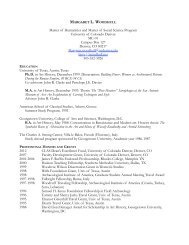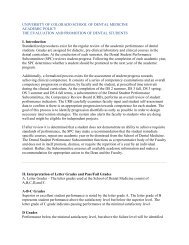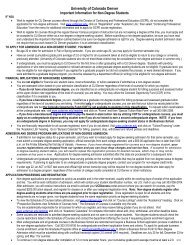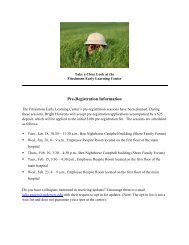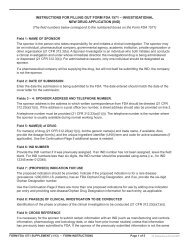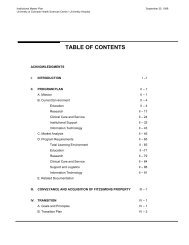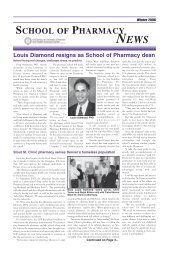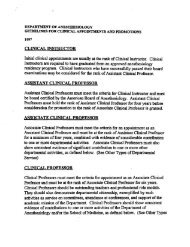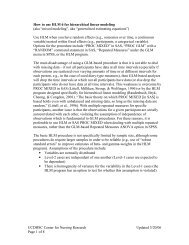Giant Orbital Cysts After Strabismus Surgery - University of Colorado ...
Giant Orbital Cysts After Strabismus Surgery - University of Colorado ...
Giant Orbital Cysts After Strabismus Surgery - University of Colorado ...
Create successful ePaper yourself
Turn your PDF publications into a flip-book with our unique Google optimized e-Paper software.
more, immunostaining analysis was remarkable for the<br />
cytokeratin-7 marker, suggesting an epithelial-derived tumor.<br />
Systemic evaluation was negative for a primary<br />
malignancy. The patient’s right eye became prephthisical<br />
and painful. Because the potential for rehabilitation was<br />
considered extremely poor, the right eye was enucleated.<br />
Histopathology <strong>of</strong> the globe revealed an ocular surface<br />
squamous neoplasm that appeared to invade the eye<br />
through the cataract incision site and remain contiguous<br />
with epithelial cells on the corneal endothelium and the<br />
iris epithelial tumor (Figure 3). A prominent inflammatory<br />
infiltrate was observed in the region <strong>of</strong> the iris mass<br />
(Figure 3). These findings were consistent with metaplastic<br />
epithelial downgrowth <strong>of</strong> a limbal squamous cell carcinoma<br />
with secondary intraocular inflammation. This phenomenon<br />
should be included in the differential diagnosis<br />
<strong>of</strong> chronic inflammation after intraocular surgery.<br />
REFERENCES<br />
1. Vargas LG, Vroman DT, Soloman KD, et al. Epithelial<br />
downgrowth after clear cornea phacoemulsification: report <strong>of</strong><br />
two cases and review <strong>of</strong> the literature. Ophthalmology 2002;<br />
109:2331–2335.<br />
2. Giaconi JA, Coleman AL, Aldave AJ. Epithelial downgrowth<br />
following surgery for congenital glaucoma. Am J Ophthalmol<br />
2004;138:1075–1077.<br />
3. Kim SK, Ibarra MS, Syed NA, Sulewski ME, Orlin SE.<br />
Development <strong>of</strong> epithelial downgrowth several decades after<br />
intraocular surgery. Cornea 2005;24:108–109.<br />
<strong>Giant</strong> <strong>Orbital</strong> <strong>Cysts</strong> <strong>After</strong> <strong>Strabismus</strong><br />
<strong>Surgery</strong><br />
Theodore H. Curtis, MD, Ann U. Stout, MD,<br />
Arlene V. Drack, MD,<br />
and Vikram D. Durairaj, MD<br />
PURPOSE: To describe a rarely reported complication <strong>of</strong><br />
strabismus surgery.<br />
DESIGN: Observational case series.<br />
METHODS: A review <strong>of</strong> four eyes in three patients with<br />
orbital cysts following strabismus surgery.<br />
RESULTS: Each patient had either a symptomatic strabismus<br />
or visible mass that brought them to medical attention<br />
many years, <strong>of</strong>ten decades after surgery (mean 34<br />
years). All had some degree <strong>of</strong> incomitancy. During<br />
surgery, all cysts were found to be associated with the<br />
involved rectus muscle.<br />
Accepted for publication Apr 25, 2006.<br />
From the Rocky Mountain Lions Eye Institute, <strong>University</strong> <strong>of</strong> <strong>Colorado</strong>,<br />
Aurora, <strong>Colorado</strong> (T.H.C., A.V.D., V.D.D.); and the Casey Eye Institute,<br />
Oregon Health and Sciences <strong>University</strong>, Portland, Oregon (A.U.S.).<br />
Inquiries to Vikram D. Durairaj, MD, 1675 N Ursula St, Box 6510,<br />
Aurora, CO 80045; e-mail: vikram.durairaj@uchsc.edu<br />
FIGURE 1. An intraoperative photo <strong>of</strong> a giant orbital cyst,<br />
which developed after strabismus surgery. The inferior portion<br />
<strong>of</strong> the medial rectus is shown under the muscle hook and the<br />
collapsed cyst is drawn superiorly on the suture.<br />
CONCLUSIONS: <strong>Orbital</strong> cysts are a rarely recognized complication<br />
<strong>of</strong> strabismus surgery. However, it should be<br />
considered in the differential <strong>of</strong> orbital cysts after strabismus<br />
surgery because <strong>of</strong> the risk <strong>of</strong> muscle damage<br />
during surgical excision. (Am J Ophthalmol 2006;<br />
142:697–699. © 2006 by Elsevier Inc. All rights reserved.)<br />
ORBITAL CYSTS ARE UNCOMMON LONG-TERM COMPLIcations<br />
<strong>of</strong> strabismus surgery. Herein, we report on<br />
three patients with giant orbital cysts after strabismus<br />
surgery, including one with bilateral cysts. A retrospective<br />
review <strong>of</strong> three patients with four orbital cysts after<br />
strabismus surgery was initiated after obtaining approval<br />
from the institutional review board.<br />
● CASE 1: A 52-year-old male presented with an enlarging<br />
left orbital mass for two years. His history was remarkable<br />
for esotropia with bilateral strabismus surgery at age 10,<br />
forty-two years before presentation, without subsequent<br />
eye surgeries or injuries. The motility examination showed<br />
an adduction deficit <strong>of</strong> the left eye with a left exotropia<br />
at distance. Slit-lamp examination showed a blue-hued,<br />
mildly vascular cystic mass superonasally. An orbital CT<br />
scan revealed a well-defined anterior-medial mass associated<br />
with the left medial rectus. The globe and bony orbit<br />
were otherwise normal. During surgery, the superior portion<br />
<strong>of</strong> the medial rectus was found attached to the<br />
posterior aspect <strong>of</strong> the cyst; the inferior portion <strong>of</strong> the<br />
medial rectus was attached to sclera posterior to it’s<br />
original insertion (Figure 1). Histopathology revealed a<br />
VOL. 142, NO. 4 BRIEF REPORTS<br />
697
FIGURE 2. External view <strong>of</strong> a giant orbital cyst, which developed<br />
decades after strabismus surgery in Case 3. The cyst is<br />
located over the insertion <strong>of</strong> the right lateral rectus.<br />
sudoriferous cyst with an attached stump <strong>of</strong> striated<br />
muscle.<br />
● CASE 2: A 31-year-old male presented with unsightly<br />
eye misalignment. He had strabismus surgery at age 20,<br />
eleven years before presentation. On examination, he had<br />
a large-angle exotropia, greater in right gaze. Slit-lamp<br />
examination showed bilateral conjunctival scars. No adduction<br />
deficit was appreciated. During surgery, a 10-mm<br />
bluish mass was noted attached to the left medial rectus<br />
and connected to the insertion by fibrous tissue. The cyst<br />
and the underlying muscle were resected. Histopathology<br />
revealed an epithelial inclusion cyst partially surrounded<br />
by striated muscle.<br />
● CASE 3: A 53-year-old woman presented with a fivemonth<br />
history <strong>of</strong> a right orbital mass. She had strabismus<br />
surgery as an infant, almost fifty years previously. Her<br />
motility examination showed an alternating exotropia,<br />
worse in left gaze. Slit-lamp examination revealed a large,<br />
bluish cystic lesion over the insertion <strong>of</strong> the right lateral<br />
rectus (Figure 2). The left eye was unremarkable. Preoperative<br />
magnetic resonance imaging showed a 13 11-mm<br />
cystic lesion involving the right lateral rectus; a similar 9<br />
7-mm lesion was seen within the left medial rectus<br />
(Figure 3). During surgery, the cyst was found to have<br />
intimate adhesions to the lateral rectus muscle. Histopathology<br />
showed a cyst lined by stratified and simple<br />
columnar epithelium.<br />
<strong>Giant</strong> orbital cysts after strabismus surgery are a rarely<br />
described complication. Patients can present either with<br />
the complaint <strong>of</strong> a mass or with the clinical picture <strong>of</strong> a<br />
slipped or lost muscle. 1–4 The cystic mass maybe undetectable,<br />
even on careful slit-lamp examination. One <strong>of</strong> our<br />
cases had no signs or symptoms to suggest a cyst other than<br />
FIGURE 3. T-1 weighted MRI image without contrast (axial<br />
cut) <strong>of</strong> Case 3, showing a giant orbital cyst intimately involved<br />
with both the right lateral rectus and left medial rectus at their<br />
insertions. The patient had bilateral strabismus surgery as an<br />
infant.<br />
incomitant, recurrent strabismus. The two who presented<br />
with a mass were found to have an incomitant strabismus.<br />
Incomitant strabismus as a late finding after strabismus<br />
surgery may suggest the presence <strong>of</strong> an orbital cyst. Finally,<br />
our last patient had evidence <strong>of</strong> bilateral orbital cysts. To<br />
our knowledge, this is the first reported bilateral case in the<br />
literature.<br />
The prevailing hypothesis on the etiology <strong>of</strong> these<br />
cysts is that conjunctival cells are captured by the suture<br />
material and deposited while securing the muscle or<br />
while making the scleral pass. 1 This is supported by<br />
the pathology <strong>of</strong> our cases, where muscle fibers were<br />
involved with the cystic mass. The slow growth <strong>of</strong><br />
these lesions can be inferred by the lag time between<br />
surgery and presentation. Previously, cysts were noted<br />
as long as 35 years after strabismus operations. 1,5 Our<br />
mean time between strabismus surgery and presentation<br />
was 34 years, with two presenting four decades after<br />
surgery.<br />
Although these cysts are benign, they can encroach on<br />
other orbital structures. Special care is required during<br />
surgery because <strong>of</strong> the involvement <strong>of</strong> the affected rectus<br />
muscle. Extensive dissection may be necessary. <strong>Orbital</strong><br />
cysts should be considered in the differential <strong>of</strong> orbital<br />
masses in all patients who have a history <strong>of</strong> strabismus<br />
surgery, no matter how remote.<br />
698 AMERICAN JOURNAL OF OPHTHALMOLOGY<br />
OCTOBER 2006
REFERENCES<br />
1. Kushner BJ. Subconjuctival cysts as a complication <strong>of</strong> strabismus<br />
surgery. Arch Ophthalmol 1992;110:1243–1245.<br />
2. Cibis CW, Waelterman JM. Muscle inclusion cyst as a<br />
complication <strong>of</strong> strabismus surgery. Am J Ophthalmol 1985;<br />
100:740–741.<br />
3. Basar E, Pazarli H, Ozdemir H, Kaner G. Subconjunctival cyst<br />
extending into the orbit. Int Ophthalmol 1998;22:341–343.<br />
4. Metz HS, Searl S, Rosenberg P, Sterns G. <strong>Giant</strong> orbital cyst<br />
after strabismus surgery. J AAPOS 1999;3:185–187.<br />
5. Shields JA, Shields CL. <strong>Orbital</strong> cysts <strong>of</strong> childhood-classification,<br />
clinical features, and management. Surv Ophthalmol<br />
2004;49:281–299.<br />
Real Depth Vs Randot Stereotests<br />
David A. Leske, BS, Eileen E. Birch, PhD,<br />
and Jonathan M. Holmes, BM, BCh<br />
PURPOSE: To compare the performance <strong>of</strong> real depth and<br />
Randot stereotests in strabismic and nonstrabismic patients.<br />
DESIGN: Observational case series.<br />
METHODS: Stereoacuity was tested in 182 patients with a<br />
variety <strong>of</strong> strabismic conditions, using the Frisby-Davis 2<br />
(FD2) distance stereotest, the near Frisby (nF) (both real<br />
depth tests), the Preschool Randot (nR), and Distance<br />
Randot (dR) tests (both based on Polaroid vectographs).<br />
RESULTS: Patients appreciated finer disparities with the<br />
nF test than the nR test at near and with the FD2 test<br />
than the dR test at distance.<br />
CONCLUSIONS: The type <strong>of</strong> stereotest influences measurable<br />
thresholds, and the results from different tests are<br />
not interchangeable. The choice <strong>of</strong> test should depend on<br />
the question being asked; nF and FD2 would be appropriate<br />
for determining presence or absence <strong>of</strong> stereopsis<br />
and best measurable stereopsis. The more rigorous Randot<br />
tests would be appropriate for determining subtle<br />
changes. (Am J Ophthalmol 2006;142:699–701. ©<br />
2006 by Elsevier Inc. All rights reserved.)<br />
TWO COMMONLY USED CATEGORIES OF STEREOTESTS<br />
are “real depth” tests, such as the near Frisby (nF) 1 and<br />
the distance Frisby-Davis 2 (FD2), 2,3 and Polaroid vecto-<br />
Accepted for publication Apr 28, 2006.<br />
From the Department <strong>of</strong> Ophthalmology, Mayo Clinic College <strong>of</strong><br />
Medicine, Rochester, Minnesota (D.A.L., J.M.H.); Retina Foundation <strong>of</strong><br />
the Southwest, Dallas, Texas (E.E.B.); and Department <strong>of</strong> Ophthalmology,<br />
<strong>University</strong> <strong>of</strong> Texas Southwestern Medical Center, Dallas, Texas<br />
(E.E.B.).<br />
Supported by National Institutes <strong>of</strong> Health Grants EY015799 and<br />
EY011751 (J.M.H.) and EY005236 (E.E.B.), Research to Prevent Blindness,<br />
New York, New York (J.M.H. as Olga Keith Weiss Scholar and an<br />
unrestricted grant to the Department <strong>of</strong> Ophthalmology, Mayo Clinic<br />
College <strong>of</strong> Medicine).<br />
Inquiries to Jonathan M. Holmes, BM, BCh, Ophthalmology E7, Mayo<br />
Clinic College <strong>of</strong> Medicine, Rochester, MN 55905; e-mail: holmes.<br />
jonathan@mayo.edu<br />
graph “randot” tests, such as the near Preschool Randot<br />
(nR) 4 and the new Distance Randot (dR). 5 To determine<br />
whether there are systematic differences between these<br />
categories <strong>of</strong> tests, we evaluated their performance in a<br />
large cohort <strong>of</strong> patients.<br />
One hundred and eighty-two patients in a strabismus<br />
practice, ages 4 to 84 years, with visual acuity <strong>of</strong> 20/40 or<br />
better in each eye, up to 70 prism diopters (pd) <strong>of</strong><br />
esotropia, 55 pd exotropia, or 30 pd <strong>of</strong> hypertropia completed<br />
the nF, FD2, nR, and dR stereotests as part <strong>of</strong><br />
routine evaluation. Criterion <strong>of</strong> 20/40 in each eye was used<br />
to avoid bias against Randot tests because <strong>of</strong> dot resolution.<br />
All four tests were administered using previously<br />
described presentation protocols. 3–6 The study was approved<br />
by respective Institutional Review Boards and<br />
conducted in a Health Insurance Portability and Accountability<br />
Act (HIPAA)–compliant manner. To eliminate<br />
potential bias <strong>of</strong> comparing tests with different ranges <strong>of</strong><br />
stereopsis, results were rescored as “fine” (20 to 60 seconds<br />
<strong>of</strong> arc [sec arc]), “moderate” (75 to 200 sec arc), or<br />
“coarse/nil” (400 sec arc to nil) stereo (Table 1). We<br />
compared these rescored stereopsis levels between tests and<br />
determined the frequency <strong>of</strong> one test indicating a finer or<br />
measurable threshold compared with the alternative test.<br />
At near, patients appreciated finer disparities with the<br />
nF than the nR test (median “moderate” vs “coarse/nil,” P<br />
.0001). At distance, patients appreciated finer disparities<br />
on the FD2 than the dR test (median “moderate” vs<br />
“coarse/nil,” P .0001). Only 4% <strong>of</strong> patients had better<br />
stereoacuity with nR than nF, and no patient had better<br />
stereoacuity with dR than FD2. When one test indicated<br />
nil stereopsis, the patient was much more likely to have<br />
measurable stereopsis with a real depth test (nF or FD2)<br />
than a Randot test (Table 2).<br />
One possible explanation for different median thresholds<br />
is that one or more tests were more prone to false<br />
positives. We therefore analyzed patients with 20 pd <strong>of</strong><br />
constant deviation. Only one <strong>of</strong> 21 (5%) patients with<br />
20 pd at near had measurable stereopsis with the nF and<br />
one <strong>of</strong> 25 (4%) with 20 pd at distance had measurable<br />
stereopsis the FD2 (none with the Randot tests), and that<br />
individual patient had Duane’s syndrome with marked<br />
incomitance. It is possible that, despite attempting to<br />
measure the stereoacuity in primary position, this patient<br />
adopted a subtle face turn during stereoacuity testing,<br />
reducing his angle <strong>of</strong> deviation. Previous studies have<br />
suggested that our standardized presentation protocols 3,7<br />
reduce the impact <strong>of</strong> monocular cues to a negligible level.<br />
There are at least three possible explanations why the<br />
real depth tests might demonstrate measurable stereopsis<br />
when the Randot tests demonstrate no stereopsis: (1)<br />
patients had intermittent tropias that were better controlled<br />
when viewing real world targets, (2) there was<br />
greater dissociation under conditions <strong>of</strong> Randot testing<br />
(when the deviation by alternate cover test (ACT) <br />
simultaneous prism cover test [SPCT]), and (3) the tests<br />
VOL. 142, NO. 4 BRIEF REPORTS<br />
699




